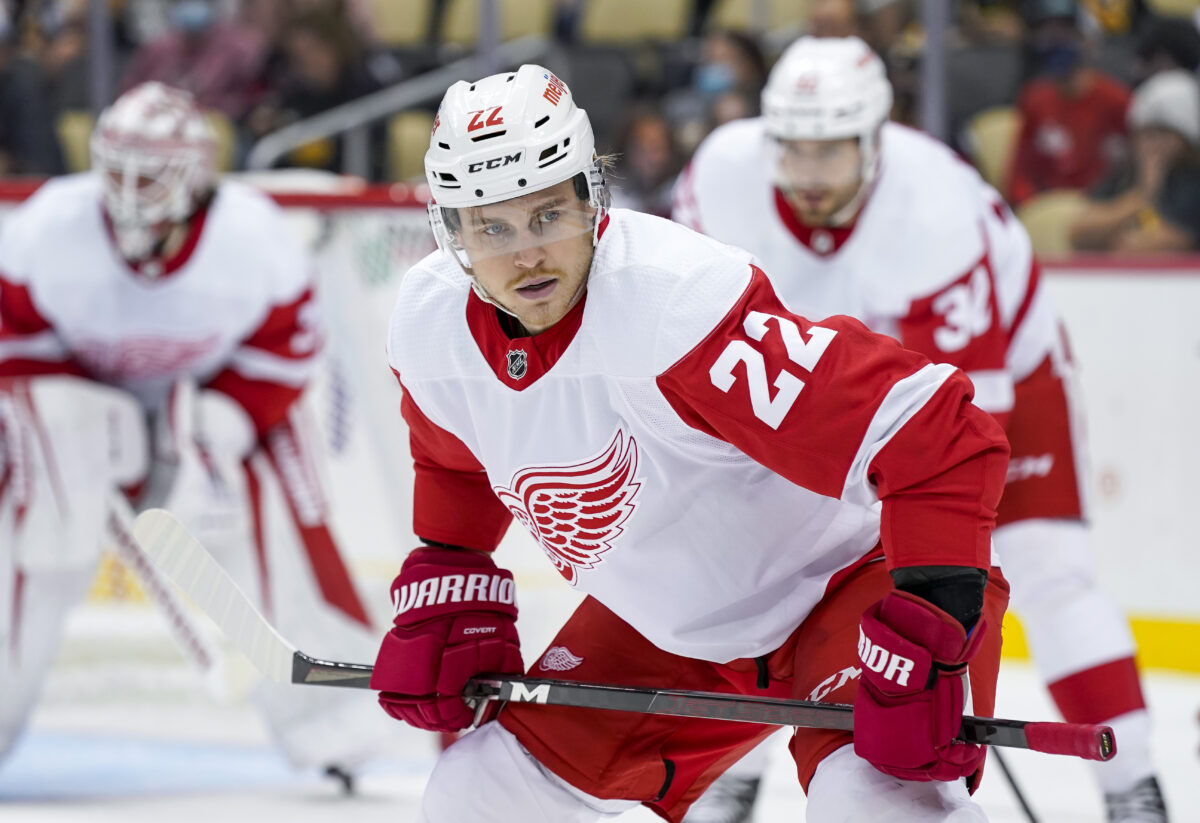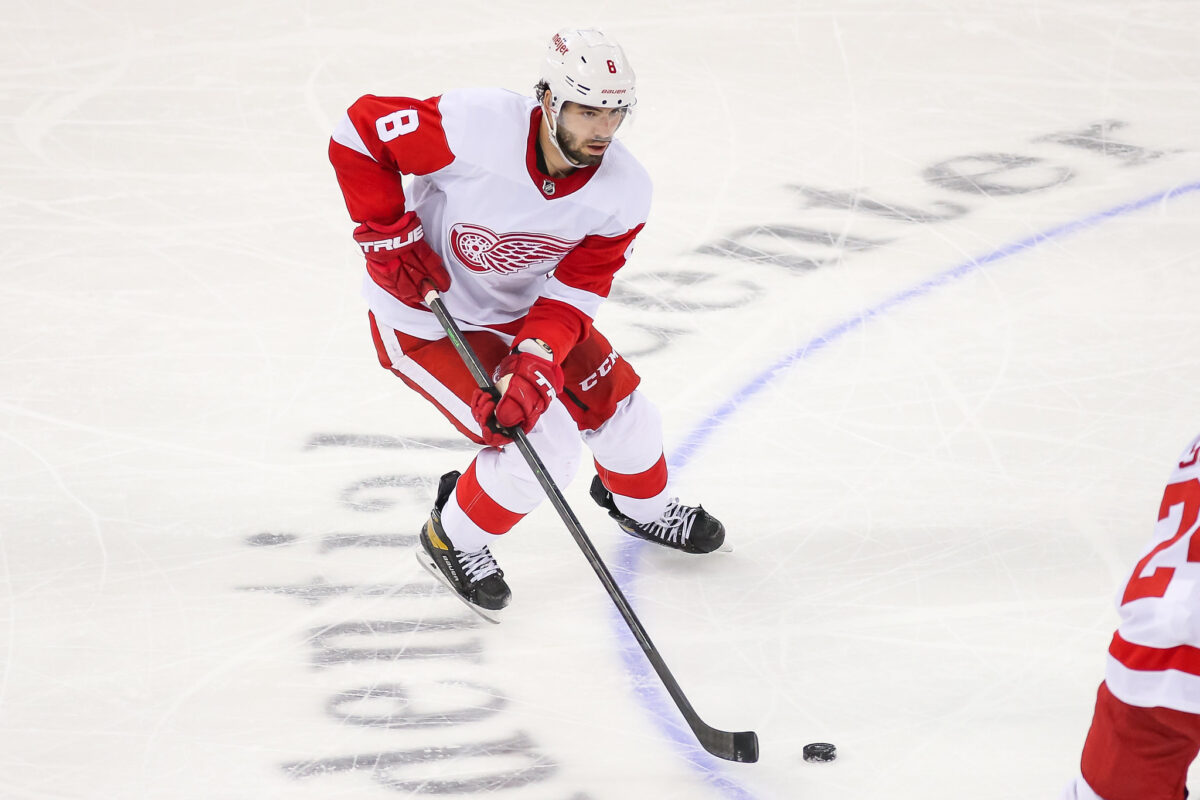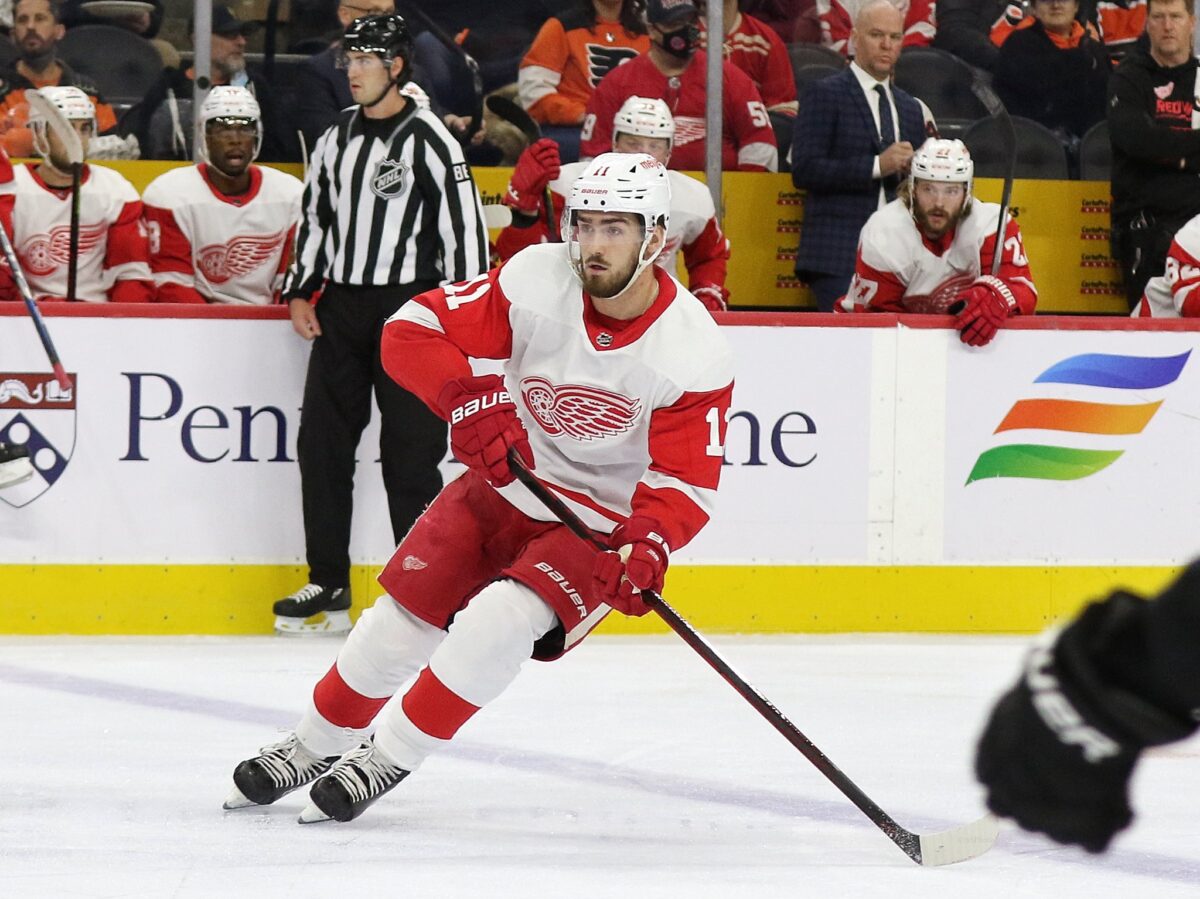Compared to the last two offseasons, Steve Yzerman and the Detroit Red Wings don’t have many restricted free agents (RFAs) to sign.
In fact, Yzerman only has eight RFAs on his plate this summer. And not all will be getting new contracts. As with every offseason, supply and demand of cap space, roster spots, and player roles will have an impact on contract negotiations.
With that being said, let’s dive into the contract projections for Detroit’s eight RFAs.
2022 Red Wings Offseason Overview
- Red Wings’ Year-Over-Year Team Analysis
- Red Wings’ Individual Player Progression/Regression in 2021-22
- Risk & Reward in Continuing the Rebuild vs. Pushing for Contention
- Analyzing the Red Wings’ Organizational Depth
Red Wings Likely to Receive a Qualifying Offer
A few RFAs could be knocked out rather quickly with qualifying offers, which are one-year contracts that come with a slight raise – the amount of which depends on the prior year’s base salary. Players can either accept the deal or hold out for a better one.
Victor Brattstrom, Chase Pearson, and Mitchell Stephens don’t have a ton of leverage heading into contract negotiations, making qualifying offers the likeliest route for the trio. All three are eligible for arbitration, but again, don’t have much of a case to present to an independent arbitrator.

One-year qualifying offers would come with the following cap hits:
- Victor Brattstrom – $787,500
- Chase Pearson – $917,831
- Mitchell Stephens – $813,750
Of the three, Stephens is the likeliest to request a higher salary than his qualifying offer. Injuries derailed his 2021-22 season, but he has the tools to be a highly effective fourth-line center. A one-year contract in the neighborhood of $900,000 would be reasonable as well.
So while Brattstrom, Pearson, and possibly Stephens are in line to receive and accept their qualifying offers, there’s a good chance Olli Juolevi, Kaden Fulcher, and Filip Larsson are not offered new contracts.
Juolevi played sparingly down the stretch after Jake Walman was brought in. There just isn’t room for him on the Red Wings’ or Griffins’ blue line.
As for Fulcher and Larsson, perhaps one is re-signed for goaltending depth in Grand Rapids or Toledo. The latter had a solid year in Sweden’s second-tier professional league, but there’s no guarantee that was enough to warrant a new deal.
Related: Iconic Red Wings Goalie Setups Through the Ages
Detroit’s Options for Jake Walman
In addition to the players noted above, it’s possible that Walman is tendered a qualifying offer and nothing else. But $787,500 seems a bit low for a defenseman of his skill set. Plus, he’s eligible for arbitration.

Instead, the Red Wings could offer a one-year deal more in line with his expected contributions. Walman recorded three goals and 10 points in 51 games last season, and had outstanding possession numbers as a member of the St. Louis Blues before joining Detroit’s mess of a blue line. In fact, Walman ranked first among Blues defensemen in Corsi-for, expected goals-for, and scoring chances-for percentages. And that defensive corps included Justin Faulk, Torey Krug, and Colton Parayko.
Rather, a one-year contract worth $1 million fits here. This would allow Walman to be an RFA again next offseason and wouldn’t be a long-term commitment on Detroit’s end for a somewhat unknown entity.
Jordan Oesterle’s $1.35 AAV is a great comparable. Oesterle and Walman are quite similar – both came to Detroit with solid possession numbers to play a bottom-pairing role. This projection would have them be paid similarly as well.
Red Wings in the Driver’s Seat with Zadina
Now onto Detroit’s most polarizing player: Filip Zadina. As we discussed previously, the 2018 first-round pick was able to generate more scoring chances and improve his defense during the 2021-22 season, but fell short when it came to hitting the scoresheet. Now, he’s up for a new contract.

From Zadina’s standpoint, he’ll likely want a one-year deal to prove himself and parlay into a more lucrative contract next summer. Consistent linemates and a new coach could help the forward do just that.
The Red Wings have a different perspective, though. In all likelihood, Zadina will improve next season and continue to grow thereafter. If you recall, Dylan Larkin’s second NHL campaign also fell way short of expectations before he exploded in Year 3. So from Detroit’s standpoint, it doesn’t make much sense to renegotiate next summer after Zadina has a breakout season.
Moreover, it would be greatly beneficial for the organization to lock the forward into a low-cap hit contract now and watch him surpass its value with ease. Detroit took this route with Michael Rasmussen last offseason, signing him to a three-year contract with a $1.46 million AAV. Rasmussen scored 15 goals in Year 1 of the contract and is an early candidate to break out next season.
It should also be noted that Zadina is not eligible for arbitration. Between that and his less-than-stellar 2021-22 campaign, he and his representation don’t have much leverage in these negotiations.
Based on Yzerman’s history with Rasmussen and Filip Hronek—both are building blocks who signed cost-effective, three-year deals coming off of their entry-level contracts—and Zadina’s lack of leverage, I would expect the two sides to agree to a three-year pact with a $1.75 million AAV. My recommendation would be to escalate Zadina’s salary – $1 million in Year 1, $1.75 million in Year 2, and $2.5 million in Year 3. This would set the forward up to be a RFA once again in 2025, and would be a win-win for both parties.
Final Contract Projections
To summarize, Detroit’s RFAs are projected to receive the following deals:
- Victor Brattstrom – One year, $787,500 AAV
- Chase Pearson – One year, $917,831 AAV
- Mitchell Stephens – One year, $813,750 AAV
- Jake Walman – One year, $1 million AAV
- Filip Zadina – Three years, $1.75 million AAV
- Olli Juolevi – Released
- Kaden Fulcher – Released
- Filip Larsson – Released
Once these contracts are finalized, the Red Wings will still be in great shape from a salary cap perspective. Factoring in the AAVs noted above, they’ll have plenty of cap space (~$32 million) if they want to pursue a few free agents this summer – or simply bank that space for later.